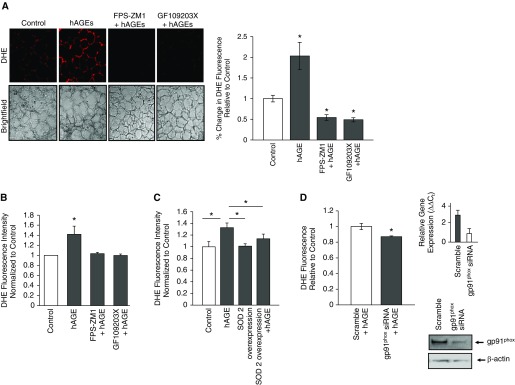Figure 6.
Challenge with hAGEs increased gp91phox–dependent reactive oxygen species (ROS) production in lung tissue slices and isolated primary alveolar type 2 cells. (A) Representative lung tissue slices challenged with hAGEs with and without FPS-ZM1, a RAGE inhibitor, or with and without GF109203X, a PKC inhibitor, and quantification of fluorescence signal shown in the bar graph. hAGEs significantly increased ROS production. Inhibition of RAGE and PKC signaling significantly decreased ROS production compared with samples treated with hAGEs alone. *P < 0.05. (B) Isolated alveolar type 2 cells treated with hAGEs with and without FPS-ZM1 show a significant increase in ROS production as measured by dihydroethidium (DHE) fluorescence. *P < 0.05. (C). SOD2 was ectopically overexpressed in rat isolated alveolar type 2 cells using adeno-associated viral construct, and then the cells were challenged with hAGEs, and ROS production measured using DHE fluorescence. Overexpression of SOD2 significantly attenuated hAGE-induced ROS production.*P < 0.05. (D) Knockdown of gp91phox significantly attenuated hAGE-induced ROS production in isolated alveolar type 2 cells. gp91phox small interfering (si) RNA efficiency was assessed by evaluating gene and protein expression; efficiency was approximately 70%. *P < 0.05.

